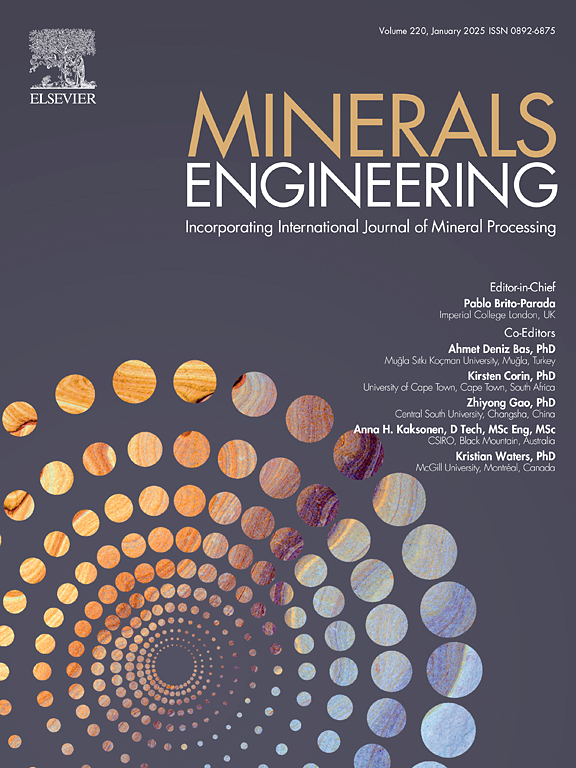三正辛基甲基氯化铵对钒的选择机理
IF 4.9
2区 工程技术
Q1 ENGINEERING, CHEMICAL
引用次数: 0
摘要
基于离子液体(IL)的萃取是一种前景广阔且对环境无害的分离技术。基于季铵的离子液体萃取钒的工艺已被广泛研究,但钒的萃取机理尚未得到准确证实。本研究考察了用三正辛基甲基氯化铵(TOMAC/CH3NClR3)溶剂萃取页岩硫酸浸出液中的钒。结果表明,在最佳条件实验中,90.50%的钒萃取率是由一个阶段组成的。这些实验在 pH 值为 1.8 的条件下进行;IL 相由 25 Vol% 的 TOMAC、15 Vol% 的 TBP 和 60 Vol% 的磺化煤油组成;O/A 相的比例为 1:7.5;萃取时间为 120 秒。利用紫外-可见分光光度计(UV-Vis)、傅立叶变换红外光谱(FT-IR)、核磁共振光谱(NMR)和热计基质辅助激光分辨飞行时间质谱(MALDI-TOF-MS)研究了钒的萃取机理。在 pH 值为 1.8 的萃取条件下,钒以 H2V10O4- 28 和 HV10O5- 28 的阴离子形式存在。由于 TOMAC 的萃取机制是阴离子交换,因此萃取出的钒主要以阴离子络合物 [(CH3NR3)4-H2V10O4- 28]/[(CH3NR3)5-HV10O5- 28] 的形式存在。通过计算 TOMAC 和 V (V) 的 ESP 图,确认了反应位点,并用于验证阴离子交换机制。本文章由计算机程序翻译,如有差异,请以英文原文为准。
Mechanism of selectivity of tri-n-octylmethylammonium chloride for vanadium
Ionic liquid (IL)-based extraction is a promising and environmentally benign separation technology. Processes for quaternary ammonium-based IL extraction of vanadium have been extensively studied, but the vanadium extraction mechanism has not been accurately confirmed. This study investigated vanadium extraction from sulphuric acid leachate of shale by solvent extraction with tri-n-octylmethylammonium chloride (TOMAC/CH3NClR3). The results indicated that 90.50 % of the vanadium extraction percentage comprised one stage under the optimal condition experiments. These experiments were carried out at pH 1.8; the IL phase consisted of 25 vol% TOMAC, 15 vol% TBP, and 60 vol% sulfonated kerosene; O/A phase ratio of 1:7.5; extraction time of 120 s. The forms of vanadium and impurities present were revealed by the solution chemistry, Medusa software simulation. The extraction mechanism of vanadium was investigated using ultraviolet spec-trophotometer (UV–Vis), fourier transform infrared spectroscopy (FT-IR), nuclear magnetic resonance spectroscopy (NMR), and hotometer matrix-assisted laser-resolved ionization time-of-flight mass spectra (MALDI-TOF-MS). Under extraction conditions at pH 1.8, vanadium was present as an anion in the form H2V10O4- 28 and HV10O5- 28. Since the extraction mechanism of TOMAC was anion exchange, the extracted vanadium was mainly present as the anionic complex [(CH3NR3)4·H2V10O4- 28]/[(CH3NR3)5·HV10O5- 28]. The ESP map of TOMAC and V (V) was calculated to confirm the reaction sites and was used to verify the anion exchange mechanism.
求助全文
通过发布文献求助,成功后即可免费获取论文全文。
去求助
来源期刊

Minerals Engineering
工程技术-工程:化工
CiteScore
8.70
自引率
18.80%
发文量
519
审稿时长
81 days
期刊介绍:
The purpose of the journal is to provide for the rapid publication of topical papers featuring the latest developments in the allied fields of mineral processing and extractive metallurgy. Its wide ranging coverage of research and practical (operating) topics includes physical separation methods, such as comminution, flotation concentration and dewatering, chemical methods such as bio-, hydro-, and electro-metallurgy, analytical techniques, process control, simulation and instrumentation, and mineralogical aspects of processing. Environmental issues, particularly those pertaining to sustainable development, will also be strongly covered.
 求助内容:
求助内容: 应助结果提醒方式:
应助结果提醒方式:


